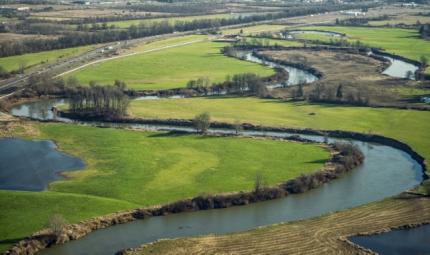Five key projects started or continued over the summer in Western Washington under the Aquatic Species Restoration Plan, a main component of the Chehalis Basin Strategy. The projects are designed to restore habitat for fish and other aquatic species and help protect communities and landscapes from flood damage.
Learn more about the projects in our July 2024 blog post.
The 2,700 square-mile Chehalis River watershed is one of the state's only major river drainage systems with no salmon species listed as threatened or endangered. However, experts studying the basin report that some salmon runs have declined as much as 80% due to a combination of lost and damaged habitat, changing climate conditions, and development.

Scientists, researchers, and technical specialists say if no action is taken in the basin, we could lose Chehalis River spring Chinook salmon entirely in 60 years. We could also lose a significant percent of the economically vital steelhead runs in that same period.
Climate change is bringing more frequent and intense fall and winter storms, spring and summer drought, and rising water temperatures to the basin. In fact, five of the largest floods in the Chehalis basin’s history have occurred in the last 30 years.
Washington State, local leaders, and people of the Chehalis Basin are able to help address these challenges through the Chehalis Basin Strategy. The Strategy is an ambitious collection of potential actions to improve and restore river habitat and reduce flood damage. It is a basin-wide strategy that includes near- and long-term actions, as well as small- and large-scale projects. The long-term goal of the Strategy is to make the basin a safer place for families and communities impacted by flooding, and to improve and restore aquatic species habitat now and for future generations.
Aquatic Species Restoration Plan
To help address the downward trend of salmon runs, representatives from the Quinault Indian Nation, Confederated Tribes of the Chehalis Reservation, Washington Department of Fish and Wildlife, and other technical experts developed a draft aquatic species restoration plan aimed at protecting and restoring aquatic habitat in the basin.
Together, the team worked with farmers, foresters, conservationists, the Department of Ecology’s Office of Chehalis Basin, other state agencies, and local governments to help shape the plan.
The science-based draft restoration plan identifies potential actions with the voluntary support of willing landowners that offer the best chance to:
- Support healthy, harvestable salmon populations
- Build robust, diverse populations of other native fish and wildlife species
- Foster productive ecosystems more resilient to climate change and human-caused stressors
The work outlined in the plan will allow river flows to connect with side channels and wetlands. This will help cool water stay in the rivers when fish need it most, enhance salmon spawning grounds up and down the river, and support overall ecosystem resiliency.
Visit the Aquatic Species Restoration Plan page for more information.
Habitat restoration projects
Over the last five years, the Washington Department of Fish and Wildlife (WDFW) initiated the design process for four “reach-scale” habitat restoration projects in different river sub-basins throughout the Chehalis Basin, including the Skookumchuck, Wynoochee, and Satsop rivers, and on Stillman Creek, a tributary to the South Fork Chehalis River.
These four projects intensively restored up to 13 miles of aquatic and riparian habitat. Funding was provided by the Washington State Legislature through the Department of Ecology’s Office of Chehalis Basin.
In addition to these four “early action reach” projects, WDFW and the Recreation and Conservation Office are working closely with local organizations, project sponsors, and community members to implement restoration projects that will improve habitat and water quality, generate jobs, and protect against flood damage across the basin.
Habitat restoration projects
- Skookumchuck River
- Satsop and Wynoochee rivers
- Stillman Creek – tributary to the South Fork Chehalis River
Fish passage barriers
The Chehalis Fish Passage Barrier Prioritization web app is a tool to help inform which fish passage barriers should be corrected first in the Chehalis Basin. Correcting fish passage barriers such as undersized culverts helps restore access to salmon spawning and rearing habitat.